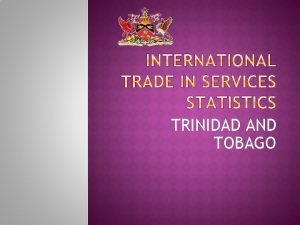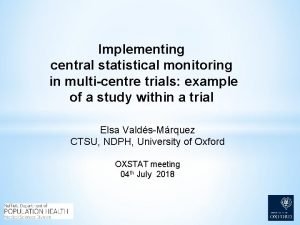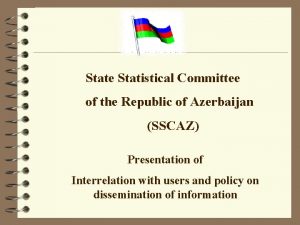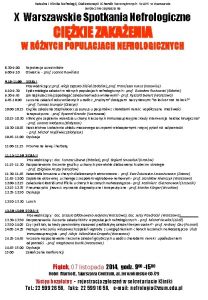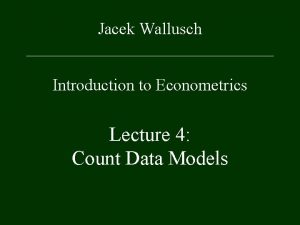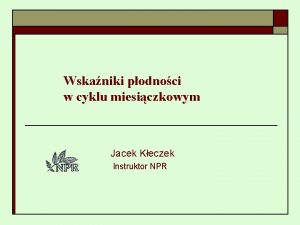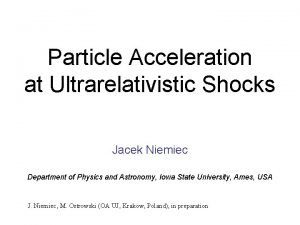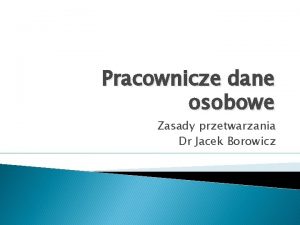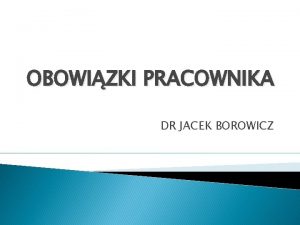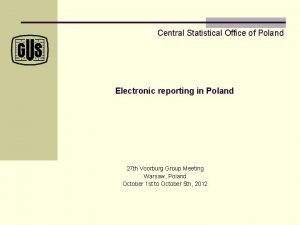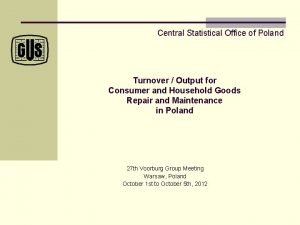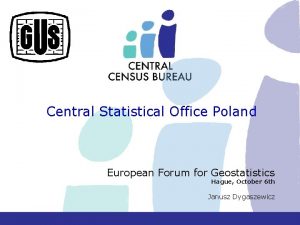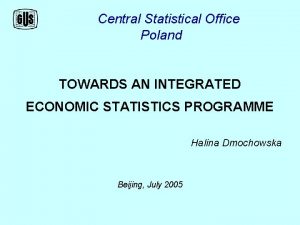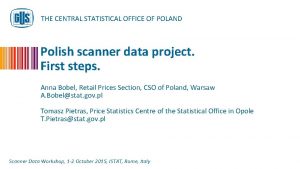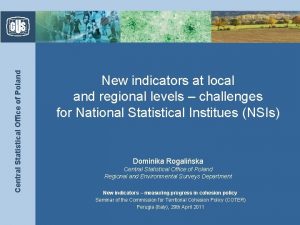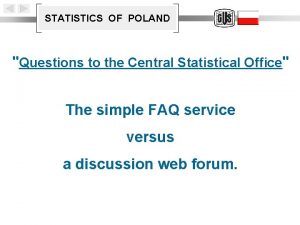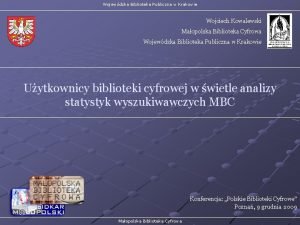Jacek Kowalewski CENTRAL STATISTICAL OFFICE OF POLAND STATISTICAL







































- Slides: 39

Jacek Kowalewski CENTRAL STATISTICAL OFFICE OF POLAND STATISTICAL OFFICE IN POZNAŃ USING A MAP OF SHORT-TERM STATISTICS IN THE PROCESS OF ORGANIZING BUSINESS SURVEYS

Inspiration • disproportion between demand supply on the information market more, faster, higher quality, more details • the need to change the functional model of statistics cost reduction, respondent burden reduction, a change in the overall coordination of surveys, forms integration • reluctance to change in statistical offices complex and extensive surveys, internal connections between surveys, the need to ensure data coherence and continuity, poor knowledge of modern statistical techniques • the need for detailed information about the whole survey system

A map of a system of statistical surveys

What is a map of a system of statistical surveys? Generalized, integrated and ordered description of statistical surveys including the following elements: • Basic information about surveys containing: survey scope, target population, survey frequency, survey administration date, data collection methods, survey implementation. • A description of input data (X) – sources and forms of data; input variables, quality assessment criteria (number of refusals, missing data, error estimates). • A description of survey results (Y) i. e. the format (raw data, adjusted seasonally or on a working day basis, trend), form of presentation (indicator, absolute value), date and place of releasing data or making them available. • A description of the transformation of input data into results, which is essential for further, more in-depth analyses.

time Data cube e c pa s variables sections, divisions, classes…

X Y input variables output variables W Data transformation processes

Matrix of Transformation where , when input variable xi is used to estimate the value of variable yj , otherwise

Implementation of short-term statistics in Poland

DG 1 survey • business activity report • the basic source of short-term information about economic activity of businesses • covers only enterprises with over 9 employees • timeliness – 5 th day after the end of each month • current prices, constant prices • digital reporting - over 90% • efforts made to use administrative registers

DG-1 SURVEY SCOPE BY THEME SALES of manufacturing output: - total - domestic - exported (of which goods exported to the Eurozone countries) of construction output: - total - by type of work - by buidling type TRANSPORT Load capacity of road transport of goods and materials: - In retail trade - online - In wholesale trade T AXES & SUBSIDIES Excise duty: - on goods produced for sale - on goods and materials Specific subsidies Transport of goods Transport of passengers - total - city transport - bus intercity transport. P NEW ORDERS New orders received: - total - domestic - exported of which orders exported to the Eurozone countries) SURVEY Z SCOPE TURNOVER Turnover: - total - domestic - exported (of which goods exported to the Eurozone countries) EMPLOYEES working persons average number of employees WORKING TIME P RICES of goods and services: - total - domestic - exported construction work price indexes SALARIES Wages and salaries Dividend Social insurance premiums time worked

Short Term Statistics Weights to calculate higher level aggregates DG-1 appendix for construction companies business activity report C-01 Producers’ prices Price indexes C-01 b Sample frame Control B-01 Sales of construction companies F-01 Revenues, financial result Z-06 Employees, wages, working time Business register Social security register

A Map of Short-term Statistics


Destinations for short-term data GUS information portal Preliminary results Announcements of the President of GUS Local Data Bank Economic indicators Macroeconomic indicators National institutions The Chancellery of the Prime Minister (KPRM ) NBP International institutions short-term Eurostat IMF OECD UN statistics International Transport Forum Internal needs of GUS Statistical surveys Secondary and supplementary analyses Analyses Publications GUS US Public journals

INTERNATIONAL INSTITUTIONS OUTPUT VARIABLES BY DOMAIN

STS INDICATORS FOR EUROSTAT THE DATE OF TRANSFERRING DATA BY POLAND AFTER THE END OF THE REPORTING PERIOD

NATIONAL OUTPUT VARIABLES – FOR THE BUSINESS SECTOR PUBLISHED BY CSO ON AN ONGOING BASIS

TRANSFORMATION MATRIX MANUFACTURING

Elements of analysis

Short-term statistics • annually over 450, 000 reports • 62 input variables • 9 thematic areas • 72 groups of output variables • 104, 000 figures released • most figures released for the variable Average monthly wage (19, 500)

Matrix of Transformation • To calculate Sales of construction and assembly output 14 input variables are required • Average number of employees is used to estimate 11 different output variables

Matrix of Transformation • Only 6 x and y variables are mutually and unequivocally matched. • They can be analysed irrespective of the whole system.

Optimization criteria Priority (weight) Time W T Yi Cost Quality C Q

Assumptions for the criteria • Priority (weight) – 3 categories of output information have been distinguished. The largest weight has been assigned to data, which are to be estimated in order to comply with international obligations or national regulations. The lowest priority has been given to supplementary information. • Release date – output values have been adopted on the basis of data release practices that have been in use so far, which are described in the Map. • The cost of obtaining a variable – has been calculated by decomposing the total cost of a survey (as described in the Survey Programme of Public Statistics) by means of a matrix of transformation M.

Number of variables Release date 16 th working day after the end of the month – first results (Average employment and Average wage) days after the end of months

Release date T • 49% of variables are monthly ones • They account for 96. 5% of all estimates in those surveys • 2/3 of output monthly variables have the highest priority • 6 input variables are used only to estimate quarterly or annual data

Costs C 1. For each l-th survey sl it is possible to determine: - the total cost of survey implementation CB(sl), 2. Based on values calculated for survey bl it is possible to determine the cost value (xc) for output variables X 3. Costs of data transformation processes (W) are minimal and therefore negligible in the model

C Costs CB x 1 x 5 x 8 y 1 y 2

Costs C • PLN 42 (~ € 10) – average cost per one report • +PLN 35 (~ € 8, 5) – average cost of report’s preparing • PLN 185 (~ € 45) – average cost of obtaining one estimate • PLN 1. 6 m (€ 380, 000) – the maximum cost of one variable: Indicator of producers’ prices on the domestic market • PLN 400, 000 (€ 95, 000) – the maximum cost of estimating one value (Base amount GN) • PLN 3 (€ 0. 70) – the lowest cost of estimating one value (Average employment)

Conclusions

What for? • The adjustment of the statistical output to changes in the surrounding environment should be treated as an ongoing process • Different actions are necessary at various levels – looking for new data sources, using modern methodologies, changing survey organisation • the need for advanced education (like EMOS) • A map of a system of surveys provides essential, integrated information about implemented surveys, which helps to identify end users and release dates, and describes relationships between different variables. In other words, the map provides a quick answer to questions about what, where, when and how. • The map has a motivational aspect • Necessary to conduct in-depth analyses • Can be useful for integrating statistical forms • The map can help to optimize surveys. A matrix of transformations with precisely described and quantified criteria is a necessary prerequisite to determine the optimal way of data processing in statistical surveys, which can be obtained by solving a problem in mathematical modeling.

Model of optimization of statistical surveys Two-stage multi-criterion problem F data acquisition processes pose a binary problem, W data transformation processes pose a combinatorial problem.

STATISTICAL OFFICE IN POZNAŃ

Ø Platforma analityczno-raportująca DG-Analysis § wdrożenie intuicyjnego i elastycznego narzędzie do analizy i raportowania danych (w technologii Java) § dostosowanie do specyfiki badania (DG-1) i środowiska (intranet – zintegrowane logowanie) § liczne grono odbiorców - oddziały US Poznań, GUS, urzędy statystyczne § parametryzowane zestawienia tworzone przez zespół projektantów § ciągły rozwój platformy (ostatnio rozszerzono o wizualizację na mapach) § w przypadku wizualizacji kartograficznej możliwe tworzenie zestawień zbiorczych (np. odrębnie dla każdego województwa w podziale na powiaty)

Surveys b 1 Information x 1 x 2 b 2 x 3 b 3

Statistical information Comparison is the essence of statistics (S. Waszak) Sundgren (1973): information is defined as a message content: K : = <O, X, x, t> where K – infological message, O – described object, X – object attribute, x – attribute value X, t – time when attribute X of object O has value x. Metadata

Repozytorium metadanych wg grup Klasyfikacje Słownik Pojęć Dziedziny Metadane Definicyjne Listy Kodów Badania i metodologiczne Akty prawne Definicje badań Zmienne Metadane operacyjne Program badań Harmonogramy Opisy struktur wielowymiarowych Struktury SDMX Definicje algorytmów Opisy źródeł danych Opisy Rejestrów (BJS), kartotek) Opis bazy obowiązków sprawozdawczych Wskaźniki jakości Definicje procesów Strukturalne Operacyjne Jakości Procesowe

Analysis of the processing of the DG-1 survey 18 255 81 393 17 921 (98, 2%) 14 071 (17, 3%) Sample 31 992 9, 6% refusals 5, 1% reminders 4, 5% explanations URZĄD STATYSTYCZNY W POZNANIU

Analysis of the processing of the DG-1 survey 18 255 81 393 17 921 (98, 2%) 14 071 (17, 3%) sample sections, divisions, classes aggregation generalization URZĄD STATYSTYCZNY W POZNANIU
 Kowalewski
Kowalewski Abscessus pulmonis
Abscessus pulmonis Central statistical office trinidad
Central statistical office trinidad Central statistical monitoring
Central statistical monitoring Sscaz
Sscaz Ceenet
Ceenet Jacek buczyński psycholog
Jacek buczyński psycholog Jacek brzost
Jacek brzost Dominik wojtczak lekarz
Dominik wojtczak lekarz Jacek wallusch
Jacek wallusch Jacek kobierzycki toya
Jacek kobierzycki toya El greco resurrection
El greco resurrection Dr jacek borowicz zakaz wykonywania zawodu
Dr jacek borowicz zakaz wykonywania zawodu Ten dzie
Ten dzie Jacek zalewski policja
Jacek zalewski policja Jacek wallusch
Jacek wallusch Jacek dobaczewski
Jacek dobaczewski Jacek kwaśniak
Jacek kwaśniak Jacek kłeczek
Jacek kłeczek Jacek wiewiorowski
Jacek wiewiorowski Jacek becla
Jacek becla Jacek otwinowski
Jacek otwinowski Jacek kopecky
Jacek kopecky Metapiron
Metapiron Jacek i placek wieś
Jacek i placek wieś Jacek juwa policja
Jacek juwa policja Jacek niemiec
Jacek niemiec Jacek kramarz
Jacek kramarz Jacek paziewski arimr
Jacek paziewski arimr Miłość tadeusza do zosi
Miłość tadeusza do zosi Jacek kasznicki
Jacek kasznicki Jacek mlynarek
Jacek mlynarek Maszyna prosta
Maszyna prosta Dr jacek borowicz zakaz wykonywania zawodu
Dr jacek borowicz zakaz wykonywania zawodu Dr jacek borowicz zakaz wykonywania zawodu
Dr jacek borowicz zakaz wykonywania zawodu Jacek kasznicki
Jacek kasznicki Jacek borowicz
Jacek borowicz Jacek kramarz
Jacek kramarz Jacek ostwald
Jacek ostwald Skewness formula
Skewness formula


